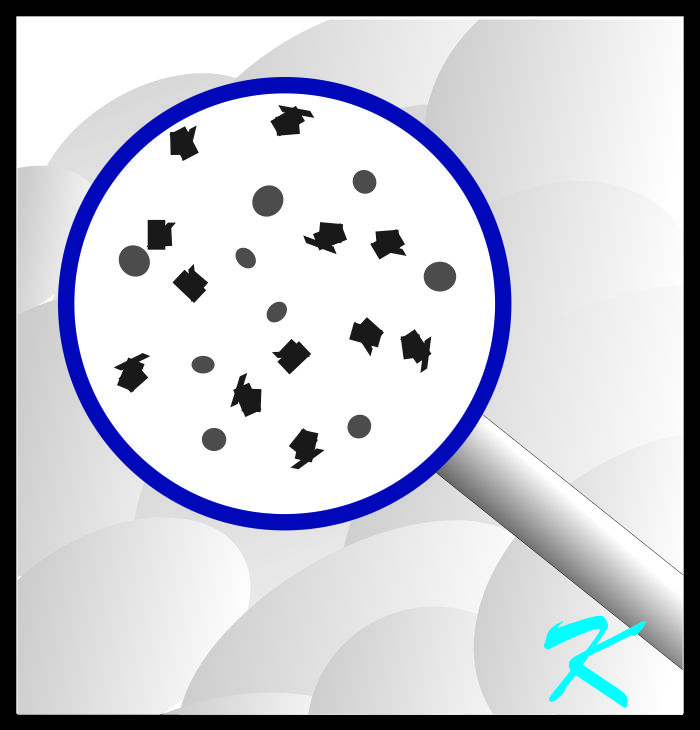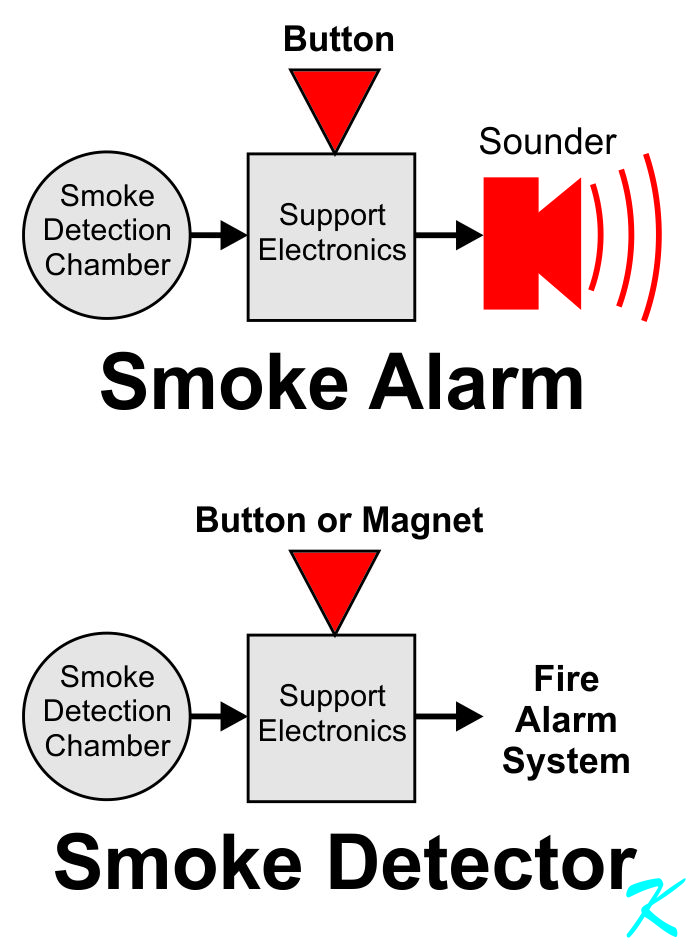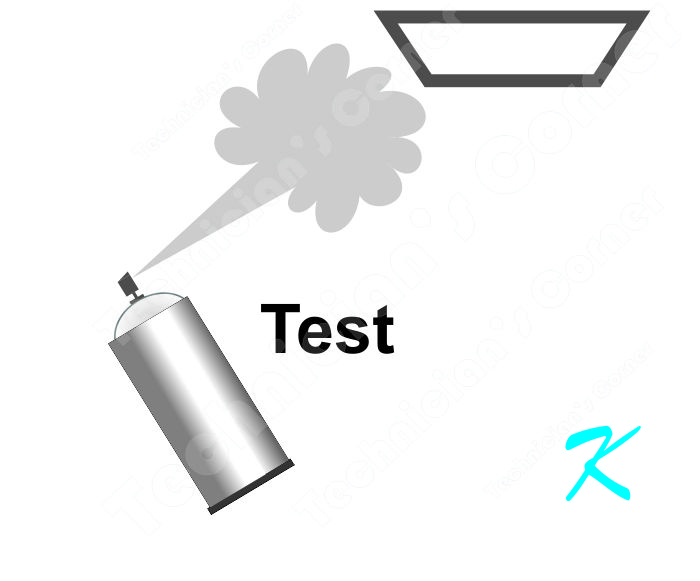The overall questions seem to be, "Why isn't using the button to test smoke alarms good enough?", "Will the artificial smoke reduce the life of the detectors?", and "Can all homeowners actually test the detectors using artificial smoke?"
To understand fully why smoke detectors or smoke alarms should be tested with canned smoke, some background of how a smoke alarm works in the first place is needed.
The question also is to be addressed about whether smoke from a can, or smoke from a pen, damages the smoke detectors.
Smoke Detection

A smoke alarm or smoke detector doesn't detect smoke; a smoke alarm or smoke detector senses particles in the air, and calls the particles smoke.
Smoke is made up of various sized unburnt particles (both solid and liquid), some various sized burnt particles, and gasses. The best that that any smoke detector can detect, though, is the particles.
Photo Smoke Detectors
These particles reflect some of the light, and they block some of the light. Photo type smoke alarms use this principle. Depending on how the photo smoke detector is designed, when either too much light is blocked by these particles, or else too much light is reflected by these particles, photo type smoke detectors sense excess particles, and go into alarm.
Ion Smoke Detectors
Using a very, very small amount of radioactive material, the particles in the air are ionized. Ionized particles change the conductivity of the air (the air's ability to carry electricity).
Ion type smoke detectors use this principle. When the conductivity of the air changes, the smoke alarms or smoke detectors go into alarm.
Sections of a Smoke Alarm or Smoke Detector

Smoke is Detected in the Smoke Detection Chamber
For a photo type of smoke alarm or detector, the chamber is a black box that allows air to pass through it. The only electronics inside the detection chamber are a photo-transistor and an LED.
For an ion type of smoke alarm or detector, the chamber is a metal box containing the radioactive material, and containing two electrical probes. The radioactive material ionizes the particles in the air, and the probes are connected to the support electronics. However, there are no electronics inside the smoke detection chamber.
When the smoke alarm is a combination photo smoke alarm and ion smoke alarm, there are two independent chambers: photo and ion. Either chamber can activate the support electronics.
The electronic signal from either type of chamber is very simple; when the chamber detects particles in the air, the electrical current / voltage / resistance of the chamber changes.
Support Electronics
To support the detection chambers, electronic circuitry is used to receive the signal showing there are particles inside the chamber, and to report the alarms. The electronic circuitry can be fancy, complete with a microcomputer, or the circuitry can be basic, using only a couple of dozen active and passive components.
The electronic circuitry also turns on the red light, sends the alarm signal on to other devices, and if it's a smoke alarm, it turns on a loud sounder.
Button or Magnet
A button or magnetic sensor commonly used for testing is a switch which is activated either with a finger or a magnet. Electrically, there is almost no difference between the switch on the smoke alarm, the magnetic sensor on the smoke detector, and the light switch on the wall.
For testing for what would happen if the chamber did detect particles in the air, the button or magnet is good for testing to see if the smoke detector has power.
All the switch does, though, is pretend that the chamber has detected particles in the air. In some respects, it overrides the signaling from the chamber and inserts its own detection signal.
Because the button or magnet does not detect the particles, the button or magnet does not test whether smoke (particles in the air) will be detected by the smoke alarm or smoke detector.
Using smoke from a can, I've tested smoke detectors that had been tested by others, for years, using magnets. In one condominium building, the magnet activated the smoke detectors every time, but no matter how much smoke I blew into the detectors, the smoke detector would not detect smoke . . . at all.
In other words, the building really had 31 magnet detectors, and no smoke detectors. All the detectors had to be replaced.
With Repeated Testing, Does Canned Smoke Accumulate in a Smoke Detector?
Using canned smoke, I've professionally tested smoke detectors (lots and lots of them) for about 20 years. Many of them, I personally tested using the canned smoke, each year, over and over and over again. I didn't find any that failed because of the repeated use of the canned smoke.
Some fire alarm system manufactures don't even provide the ability to test their detectors with buttons or magnets; smoke is the only way of testing their smoke detectors.
Also, some of the manufacturers actually provide the ability to measure how dirty the detectors have become, electronically. Although some those smoke detectors have been tested with the canned smoke every year for more than 20 years, none of those smoke detectors have become dirty because of the canned smoke.
Yes, smoke detectors become dirty. Spray paint, plaster dust, floor sweepings, dusting sprays, wood dust, linen lint, etc. all cause smoke detectors to get dirty, but canned smoke does not.
In essence, I have never found that canned smoke causes a smoke detector to become oversensitive or dirty. There have been many other causes of oversensitivity or dirtiness in smoke detectors, but canned smoke is not one of the causes.
Homeowners Testing the Smoke Detectors
On one hand, a smoke detector, that sounds off when a button is pressed, but won't detect smoke, can be considered more dangerous than not having a smoke detector in the first place. When there's a smoke detector that doesn't detect smoke, the resident has an unrealistic peace of mind.
On the other hand, homeowners have a really wide range of capabilities. Some of them are perfectly capable of installing the detectors, and testing them; some of them have difficulty figuring out why there's a beep in the house, and really don't have the ability to replace the battery.
If a homeowner can't replace a battery, handing them a can of smoke won't do any good.
I really don't know how to deal with the State Law that requires smoke to test the smoke detectors. For homeowners, there's a wide range of abilities, so this is a difficult problem. Many people are going to have to think about it.
Smoke Pens
A lot of smoke pens, used to create the smoke to test detectors, require open flames to start the smoke. I, personally, would never, ever, suggest to a homeowner that a smoke pen should, or even could, be used.
Canned smoke is far safer.
Douglas Krantz



